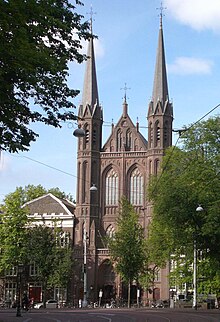De Krijtberg
De Krijtberg - actually Sint-Franciscus Xaveriuskerk - is a Roman Catholic church in the city center of Amsterdam . It was built in its current form in 1881 in neo-Gothic style and is one of the oldest and most important branches of the Jesuit order in the Netherlands .
history
In 1628 the Jesuit Pieter Laurenz (1588–1664) , who came from Saint Omer , set up a house chapel in a private house on the Singel , in which a Catholic congregation met from 1654. Since the Catholics were not allowed to practice their religion in the Netherlands at that time, the church operated in secret and was not externally recognizable as such. Their parish room , a typical Schuilkerk (“hidden church”), which fits into an inconspicuous residential and merchant's house, was dedicated to Saint Francis Xavier . The house owes its peculiar name De Crytberghen (Dutch for The Chalk Cliffs ) to the chalk cliffs of Dover : the previous owner of the house, a shipping entrepreneur, operated shipping connections to the English south coast and named his house after the destination of his ships. The rear part of the church was accessible via a small side street, the Katersteeg, which connected the Singel with the Herengracht behind .
The changed function and the ecclesiastical sponsorship of the house were by no means hidden from the public authorities, but the presence of the Catholics and their secret religious practice were tacitly tolerated. In 1677 this first church was replaced by a second, larger one, which, like its predecessor, remained inconspicuously hidden behind the bourgeois facade as a result of the influx it experienced. Even when the Jesuit order was banned in Holland in 1708 and completely repealed by Pope Clement XIV in 1773 , the chapel remained in operation.
In 1796, Catholics in the Netherlands were given the right to practice their religion freely and were thus able to build public churches. In 1835 the chapel was expanded again and the original De Crytberghen house was torn down to make way for the enlarged church and a rectory , which still houses some parish halls and the premises of the Jesuit community. From then on, the acronym ihs, which is typical of the Jesuit order, stood on the gable of the entrance portal of the new facade .
When the hierarchy of the Catholic Church in the Netherlands was restored in 1853, the church was assigned to the diocese of Haarlem , together with the second Jesuit church in Amsterdam, De Saaier . Increasing membership in the congregation seemed to justify the construction of a larger church, which was commissioned to build in 1879. The new church, for the construction of which several historic houses on Singel and Katersteg were safely demolished, was built in neo-Gothic style by Alfred Tepe (1840–1920) and consecrated on December 3, 1883 by the then Bishop of Haarlem .
When general attendance at church services and church affiliation among the Amsterdam population declined drastically from the 1960s, the closure and even the demolition of the Krijtberg were considered, however the Bishop of Haarlem withdrew his plans to close in 1974 after the church was taken off the public Authorities classified as a historic building and placed under monument protection. As a result, De Krijtberg was extensively renovated; the work was completed in 2003.
Furnishing
In line with contemporary tastes, the three-aisled interior was furnished with numerous expansive image programs, which contrast sharply with the sobriety of the Reformed churches in Amsterdam and which clearly followed the endeavor to express the full restoration of Catholicism in Amsterdam after 1853 in artistic terms. When the building was completed, the church interior received temporary wall paintings in the years 1886–1889, which were replaced from 1892 by the works by Martin Schenk (1933–1911) that are visible today.
The leaded glass windows as well as the high altar and canopy and numerous other interior elements come from the Cologne workshop of Friedrich Wilhelm Mengelberg and were made between 1882 and 1886. The choir screen, which separates the chancel from the community room by a panel, comes from the same workshop : It shows individual representations of the twelve apostles and is surmounted by a group of calvaries, in which Mengelberg predominantly followed medieval iconography . The left aisle leads into a Lady Chapel , the high altar of which in turn comes from Mengelberg's studio (1885) and depicts scenes from the life of Mary in medieval forms.
The walls of the main nave are dominated by sandstone sculptures of prominent Jesuit saints (including Franz Xavier , Ignatius von Loyola , Alphonso Rodriguez). The stained glass windows - also from Mengelberg's workshop - depict saints from the Society of Jesus ( Peter Claver , Aloisius von Gonzaga and others).
organ
In addition to a smaller psalm organ from 1960 (left transept), the church has a second organ from the workshop of Piet J. Adema en Zonen (Amsterdam) from 1905; it has been in the gallery above the right aisle since 1985 . The instrument has 33 stops on two manuals and a pedal.
|
|
|
||||||||||||||||||||||||||||||||||||||||||||||||||||||||||||||||||||||||||
literature
- Annemieke Hogervorst u. a., De Krijtberg . Amsterdam 1985.
- Paul Begheyn, "305 jaar De Krijtberg aan het Singel", in: Ons Amsterdam 56 (2004), no. 3, pp. 114–118.
- Lydia Lansink / Peter van Dael, De Nieuwe Krijtberg: A neo-Gothic droom. Amsterdam 1993.
- Peter van Dael / John Vrieze, Schoon en vroom: Art in de kerk aan het and van de vorige eeuw bij reformeerden en kathieken . Amsterdam 1980.
Individual evidence
Web links
Coordinates: 52 ° 22 ' N , 4 ° 53' E



